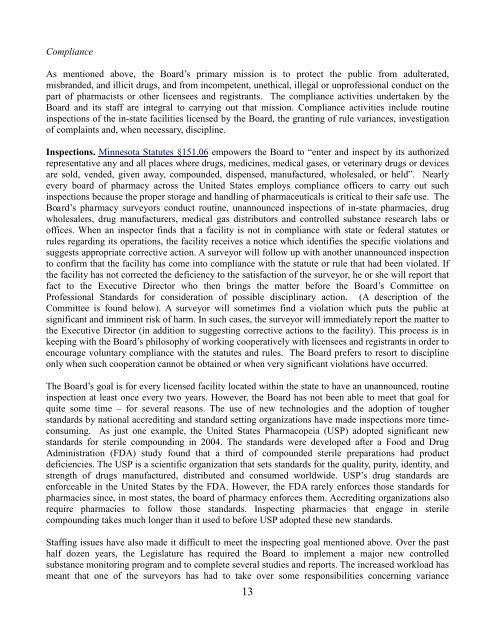Minnesota Board of Pharmacy - Minnesota State Legislature
Minnesota Board of Pharmacy - Minnesota State Legislature
Minnesota Board of Pharmacy - Minnesota State Legislature
You also want an ePaper? Increase the reach of your titles
YUMPU automatically turns print PDFs into web optimized ePapers that Google loves.
Compliance<br />
As mentioned above, the <strong>Board</strong>’s primary mission is to protect the public from adulterated,<br />
misbranded, and illicit drugs, and from incompetent, unethical, illegal or unpr<strong>of</strong>essional conduct on the<br />
part <strong>of</strong> pharmacists or other licensees and registrants. The compliance activities undertaken by the<br />
<strong>Board</strong> and its staff are integral to carrying out that mission. Compliance activities include routine<br />
inspections <strong>of</strong> the in-state facilities licensed by the <strong>Board</strong>, the granting <strong>of</strong> rule variances, investigation<br />
<strong>of</strong> complaints and, when necessary, discipline.<br />
Inspections. <strong>Minnesota</strong> Statutes §151.06 empowers the <strong>Board</strong> to “enter and inspect by its authorized<br />
representative any and all places where drugs, medicines, medical gases, or veterinary drugs or devices<br />
are sold, vended, given away, compounded, dispensed, manufactured, wholesaled, or held”. Nearly<br />
every board <strong>of</strong> pharmacy across the United <strong>State</strong>s employs compliance <strong>of</strong>ficers to carry out such<br />
inspections because the proper storage and handling <strong>of</strong> pharmaceuticals is critical to their safe use. The<br />
<strong>Board</strong>’s pharmacy surveyors conduct routine, unannounced inspections <strong>of</strong> in-state pharmacies, drug<br />
wholesalers, drug manufacturers, medical gas distributors and controlled substance research labs or<br />
<strong>of</strong>fices. When an inspector finds that a facility is not in compliance with state or federal statutes or<br />
rules regarding its operations, the facility receives a notice which identifies the specific violations and<br />
suggests appropriate corrective action. A surveyor will follow up with another unannounced inspection<br />
to confirm that the facility has come into compliance with the statute or rule that had been violated. If<br />
the facility has not corrected the deficiency to the satisfaction <strong>of</strong> the surveyor, he or she will report that<br />
fact to the Executive Director who then brings the matter before the <strong>Board</strong>’s Committee on<br />
Pr<strong>of</strong>essional Standards for consideration <strong>of</strong> possible disciplinary action. (A description <strong>of</strong> the<br />
Committee is found below). A surveyor will sometimes find a violation which puts the public at<br />
significant and imminent risk <strong>of</strong> harm. In such cases, the surveyor will immediately report the matter to<br />
the Executive Director (in addition to suggesting corrective actions to the facility). This process is in<br />
keeping with the <strong>Board</strong>’s philosophy <strong>of</strong> working cooperatively with licensees and registrants in order to<br />
encourage voluntary compliance with the statutes and rules. The <strong>Board</strong> prefers to resort to discipline<br />
only when such cooperation cannot be obtained or when very significant violations have occurred.<br />
The <strong>Board</strong>’s goal is for every licensed facility located within the state to have an unannounced, routine<br />
inspection at least once every two years. However, the <strong>Board</strong> has not been able to meet that goal for<br />
quite some time – for several reasons. The use <strong>of</strong> new technologies and the adoption <strong>of</strong> tougher<br />
standards by national accrediting and standard setting organizations have made inspections more timeconsuming.<br />
As just one example, the United <strong>State</strong>s Pharmacopeia (USP) adopted significant new<br />
standards for sterile compounding in 2004. The standards were developed after a Food and Drug<br />
Administration (FDA) study found that a third <strong>of</strong> compounded sterile preparations had product<br />
deficiencies. The USP is a scientific organization that sets standards for the quality, purity, identity, and<br />
strength <strong>of</strong> drugs manufactured, distributed and consumed worldwide. USP’s drug standards are<br />
enforceable in the United <strong>State</strong>s by the FDA. However, the FDA rarely enforces those standards for<br />
pharmacies since, in most states, the board <strong>of</strong> pharmacy enforces them. Accrediting organizations also<br />
require pharmacies to follow those standards. Inspecting pharmacies that engage in sterile<br />
compounding takes much longer than it used to before USP adopted these new standards.<br />
Staffing issues have also made it difficult to meet the inspecting goal mentioned above. Over the past<br />
half dozen years, the <strong>Legislature</strong> has required the <strong>Board</strong> to implement a major new controlled<br />
substance monitoring program and to complete several studies and reports. The increased workload has<br />
meant that one <strong>of</strong> the surveyors has had to take over some responsibilities concerning variance<br />
13

















